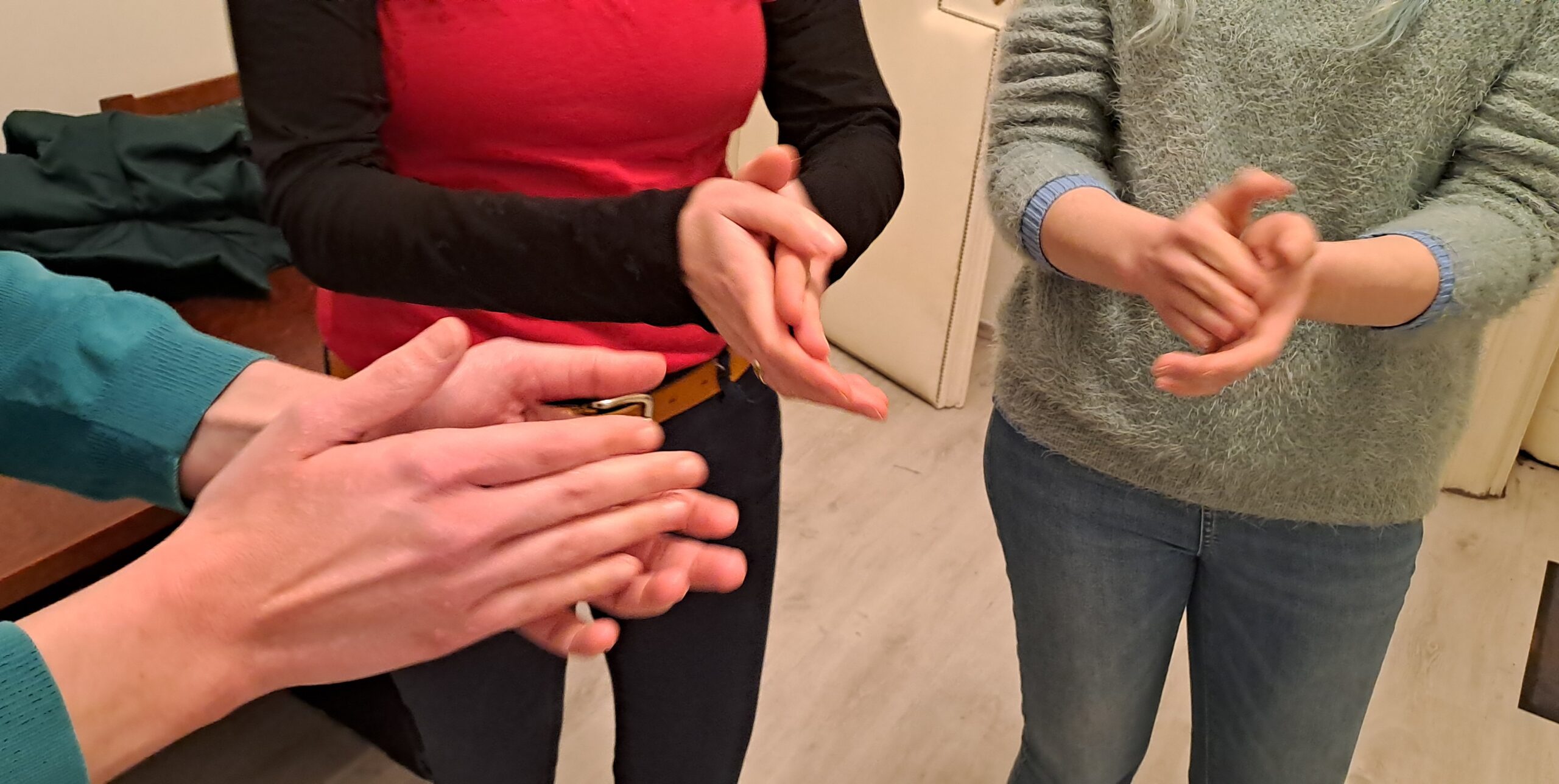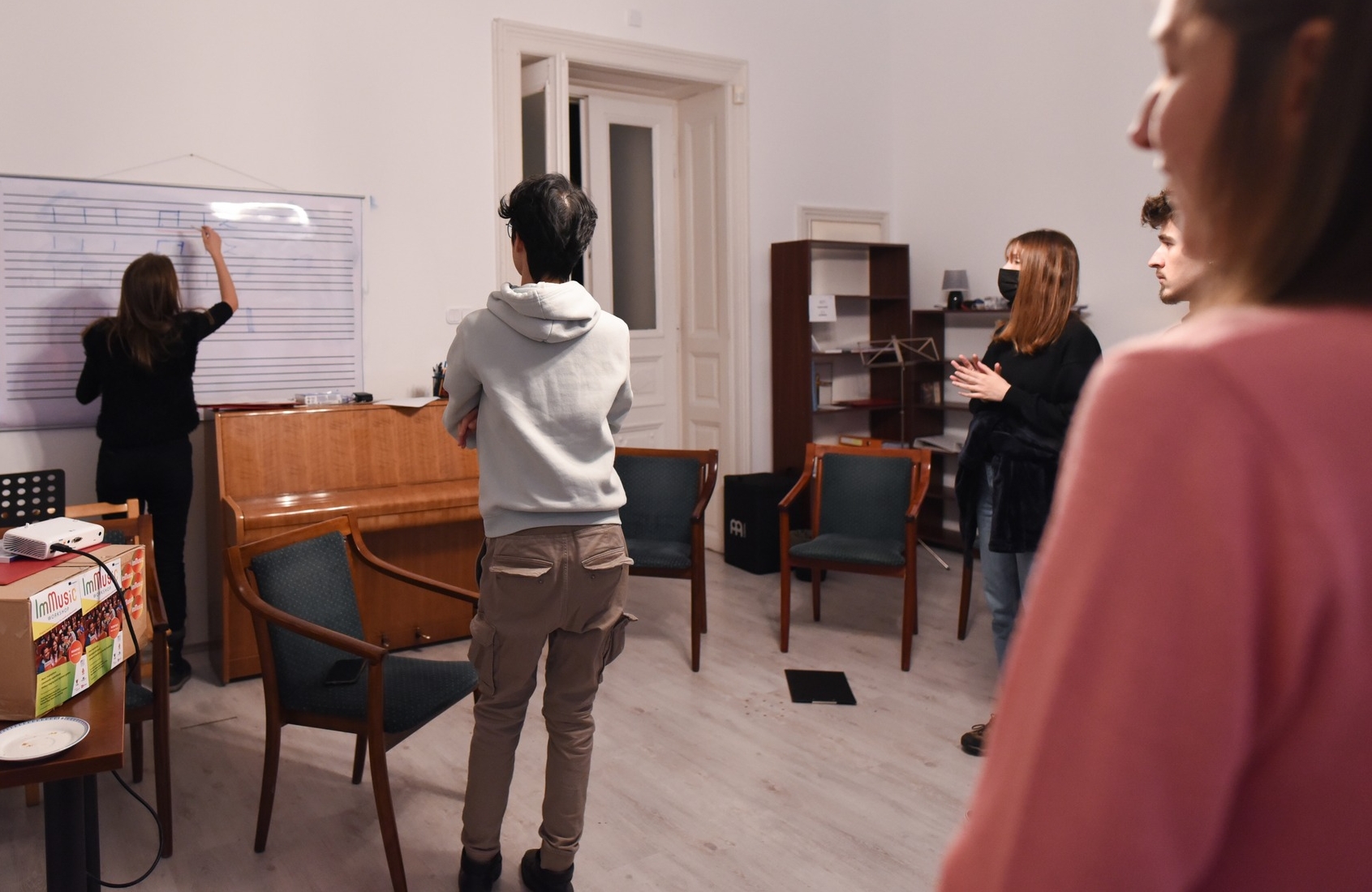by immusic | Nov 30, 2022
Category
vocal
rhythm
Age
8+
Number of participants
6+
Duration
approx. 30 min.
Working method
- playing in pairs
- group work
Musical abilities of the trainers
1 2 3 4 5 6
Equipment and instruments
- music player / app to play the videos
Competences
- cultural / intercultural sensitivity
- attention
- movement coordination
- cooperation
- concentration
- perception
- expression
- sense of rhythm
Dance with Us
Get to know the culture of other European countries
through music and dance.
AIM
The purpose of the game is to strengthen the unity between the group members and in a cultural sense with the other nations living in Europe.
Description
With the help of the videos below, get to know the specifics of the dances of different nations together with the group, and try to imitate the movements!
by immusic | Nov 30, 2022
Category
rhythm
Age
8+
Number of participants
8-25
Duration
approx. 15 min.
Working method
group work
Musical abilities of the trainers
12 3 4 5 6
Competences
- collaboration
- attention
- concentration
- rhythm recognition
1 clap 2 claps
A rhythm based game with focusing on quick reaction.
AIM
This energizer game’s main goal is to keep the participants in deep focus. It is a competitive game and who has the quickest reaction, wins.
Description
Everybody stands in the circle.
The facilitator explains the task.
The facilitator or the group choose a music to play.
After the music starts the facilitator (or any other previously chosen member of the group) starts to clap to the rhythm of the music. The participant on the facilitator’s left has to clap to the next beat. Then the next participant to the left claps to the next beat. And they keep clapping to the rhythm round the circle one by one.
This way we create a method like playing a metronome.
What makes the task harder: if somebody claps 2 times within one beat, the sequence has to change (if they went from right to left, they have to change it to left to right).
If somebody makes a mistake by clapping not according to the order that participant is out of the circle.
This competition ends when 2 participants remain in the circle.
by immusic | Nov 30, 2022
Category
vocal
Age
8+
Number of participants
8-20
Duration
approx. 30 min.
Working method
Musical abilities of the trainers
1 2 3 4 5 6
Competences
- collaboration
- creativity
- attention
- concentration
- rhythm recognition
- sense of rhythm
Cooperative Vers(us)e
Creating lyrics together as a team and singing in canon.
AIM
Helps group dynamics, improves creativity and vocality.
Description
Everybody stands in the circle. The facilitator explains the task.
The participants have to figure out short lyrics.
Possible variations depending on the abilities and motivation of the groups:
– use well known songs – change the lyrics
– use only the lyrics without music, only rhythm like rap
– create your own music as well along with the lyrics
The facilitator divides the group of ~4 small groups.
The lyrics they created has to be singed as follows:
First group starts singing the first verse.
When first group finishes the first line, the second group starts singing the song from the beginning.
When second group finishes the first line, the third group starts singing the song from the beginning.
And so on…
For example:
1st group – La La LA La La – Le Le LE Le Le – Lu Lu LU Lu Lu
2nd group – La La LA La La – Le Le LE Le Le
3rd group – La La LA La La
by immusic | Nov 30, 2022
Category
rhythmic
Age
8+
Number of participants
10-30
Duration
approx. 10 min.
Working method
group work
Musical abilities of the trainers
1 2 34 5 6
Equipment and instruments
- paper, pen
- optional – any drums and rhythm instrument
Competences
- creativity
- collaboration
- attention
- concentration
- rhythm recognition
Rhythm Map
In this game sheets with special characters (any character
that are not on a classic sheet) have to be created
and performed by the team.
AIM
This is a game for improving cooperation skills and developing focus in a creative way. Creating the sheet and coming up with rhythms is a great team building exercise. By living in the rhythm create a fun atmosphere.
Description
The facilitator creates two groups and explains the task.
First group has to find out a specific rhythm pattern that the other group needs to play on their bodies or rhythm instruments. This part of the game is like a music sheet creation task: they have to capture the rhythm, however they cannot use classic notes but symbols.
For example:
instead of „ ♪ ♫ ” they can use symbol “$” and they have to explain it means: beat with your feet
or with the symbol „❤” they want the other group to clap their hands etc.
When the first group finishes, the second group performs it based on the instructions – as a music reading task.
by immusic | Nov 30, 2022
Category
vocal
Age
8+
Number of participants
8-25
Duration
approx. 15 min.
Working method
group work
Musical abilities of the trainers
1 2 3 4 5 6
Competences
- creativity
- collaboration
- attention
- concentration
- musical hearing
- rhythm recognition
Composition Game
In this game sheets with special characters – any character
that are not on a classic sheet – have to be created
and performed by the team.
AIM
This is a game for improving cooperation skills and developing focus in a creative way. Creating the sheet and coming up with a song with rhythms is a great team building exercise. By listening to the song to be performed, it adds to the fun atmosphere.
Description
The facilitator creates two groups and explains the task.
First group has to find a simple song that the other group needs to play on a music device or by heart. This part of the game is like a music sheet creation task: they have to capture the song, however they cannot use classic notes but symbols.
For example:
instead of „ ♪ ♫ ” they can use symbol “$” and they have to explain it means: sing „LA”
or with the symbol „❤” they want the other group to sing another note
etc
When the first group finishes, the second group performs it based on the instructions – as a music reading task.






Recent Comments